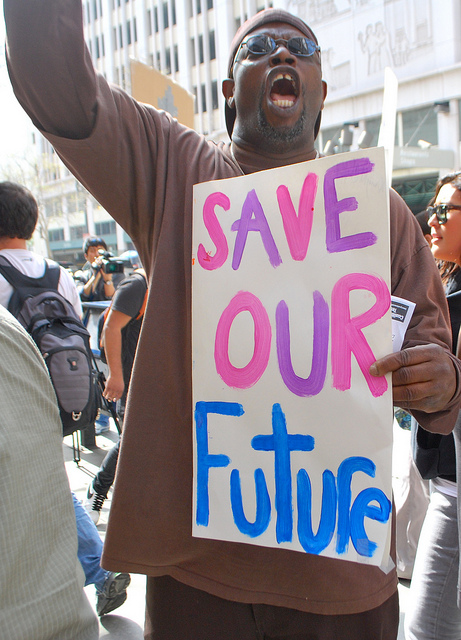Currently, the United States is $19,014,777,160,000 in debt.
Of that, $1.3 trillion is student debt and this number is increasing at a steady rate. College students and graduates across the nation want to know what the government is going to do to prevent crippling student loans from keep students from being the most productive they can be as they enter the workforce.
The average four-year public school costs $9,139 a year, but if you have chosen to attend a private school, you’re looking at an average of $32,231 a year. According to the Wall Street Journal, “the average class of 2015 graduate with student-loan debt will have to pay back a little more than $35,000”—unless you chose to go to a private institution, of course.
In America, college is no longer viewed as optional. Most jobs that never required a college degree now require at least an associate’s degree. As many economic and financial magazines will chime, “A B.A. is the new high school diploma.”
However, other countries such as Germany offer their citizens (and for some, even American citizens) a free education. Of course, this means an increase in taxes.
However, Sen. Bernie Sanders has come to rescue college students who are swimming in debt. He has proposed a bill titled, “College for All Act,” which would eliminate the $70 billion dollar tuition costs at all four-year public colleges and universities. Under the plan, the federal government would cover 67 percent of the costs, or $47 billion dollars each year.
States would be required to produce the remaining 33 percent of the costs, or $23 billion dollars.
Sanders’ website suggests that in a competitive global economy, it is essential to have the best workforce in the world. To hold back thousands of students who are intelligent and ready to learn simply because a college education is not affordable to them is ridiculous. It is setting America upon a trajectory for failure, as education is the catalyst for empowerment and without it we are incapable of knowing our history, predicting our future, and adjusting the actions of the present.
Bernie Sanders has six steps that he would take as president to make public, four-year universities debt-free.
The idea to make college debt-free is not such a radical idea.
Last year, Germany finally completely overhauled tuition because the mere $1,300 students were being charged was discouraging potential students. Other countries plan to follow in Germany’s example. Chile has expressed national interest in making college affordable for all. Other countries like Finland, Norway and Sweden were operating on a system of free-tuition long before Germany and Chile even considered the idea.
Education wasn’t always this expensive. In fact, some schools, like The University of California, offered free tuition until the early 80s. It wasn’t until the Reagan administration that tuition began to rise. For example, in 1965 the average tuition at a four-year public school was around $240. Some of the best-ranked colleges at the time didn’t charge any tuition. Since 2008, colleges have actually spent less money per student, but students have been spending more money per student. This is because in 2008 there was a financial “crisis” and the state budgets shrank along with institutional endowments.
But schools have undeniably hiked their tuition, so what are they spending it on? Acamdeic instruction? No. Surprisingly, despite tuition rising, instruction costs stayed basically the same. The fees are coming from increases in room and board, general administration (pencil pushers), and the ever nebulous “student services.” Student services consist of everything from concerts, even if they’re as lame as Chase Rice, to intramural sports, to marketing. In a sense, colleges are acting more like business and treating students more like customers. The increase in spending seems like a natural outgrowth of a capitalist society, one where people are making decisions that benefit themselves in the short-term. It’s worth asking if treating Amercia’s students like customers, is, in the end, going to be a disservice to everyone.
Thankfully, Sanders wants to stop the federal government from making a profit on the interest in student loans. In the next decade, an estimated $110 billion dollars will be made on loans. Sanders plans to leave this money in students’ pockets by setting the formula for interest back to where it was in 2006, reinstating the rate at 2.37 percent. Sanders also hopes to triple the federal work study program to not only help lower income students pay their way through school, but also give them valuable career experience.
Students, and especially curmudgeonly conservatives, fret over the cost of implementing such a program, but the solution to the financial woes is relatively genius.
The $75 billion a year plan could be entirely paid for by imposing a tax on a marginal fraction (a 0.5 percent speculation fee on investment houses, hedge funds, and other stock trades, as well as a 0.1 percent fee on bonds and a 0.005 percent fee charged on derivatives). Wall Street speculators nearly destroyed the economy seven years ago—don’t they owe it to the American people to help finance their futures? Once again, other countries have implemented this tax including England, Germany, France, Switzerland and China.
As Bernie Sanders’ webpage suggests, “the cost of not providing higher education must also be factored into consideration. A more educated workforce is likely to lead to higher incomes and a higher GDP for the nation, which will lead to increased prosperity, wealth, and consumer spending in its own right. In addition, families and individuals will spend their income freely instead of saving it for college tuition or using it to pay back student loans.”
The people who suggest that the private and elite institutions will be adversely affected by free tuition fail to consider the concept of military Keynesianism, which consists of the U.S government giving schools like M.I.T. and Harvard research funding. Many schools are heavily subsidized by the government in a like manner. Proponents of the system we have speak of the unfairness the middle class would suffer for the tax increases to pay for universal education, forgetting that all the money that would have otherwise gone to tuition will now be completely freed.
The American government already spends enough money on financial aid each year to cover the annual tuition bill for every undergraduate and graduate public college student in the country.
Just look at the math: in 2015, college students spent 61.8 billion on tuition, which includes benefits like Pell Grants, work study and student loans. The federal government donates, on average, $30.2 billion to grants, which benefit lower income students, 36.5 billion to tax breaks which benefit high income students, and roughly 1 billion to work study. This totals 67 billion. 67 billion is enough, once again, to cover all state students from big state schools like UCLA to small state schools like EUP.
Of course, for this to happen, some people would have to lose. Students at private schools would lose their financial aid. But, with respect to Cornell and Yale, that might not be such a bad idea.
Meanwhile, for-profit colleges (think University of Phoenix), tend to leave their students mired in debt with not much to show for it. For-profit universities consume around 1/5 or 21 percent of all available Pell grants. With 76 percent of undergraduates attending public colleges already, perhaps we should make sure their educations are affordable rather than giving students just a little bit to attend any institution they want.
Regardless, eliminating tuition wouldn’t make going to college 100% free. Books, housing and transportation are often excluded from tuition. Washington could use all the money it already spends to make public education affordable in creative ways. For example, it could allot money to states to refund their college systems on the condition that they keep costs down, instead of giving out fickle financial aid packages.
Humanity’s faith, for now, resides in Bernie Sanders who is one of two candidates who even has a policy on higher education.
Author: Emma Giering
Editor: Catherine Monkman
Photo: Neon Tommy/Flickr







Read 9 comments and reply